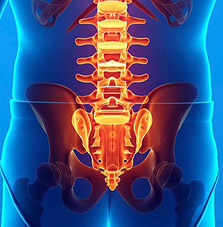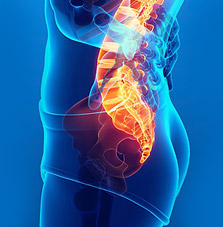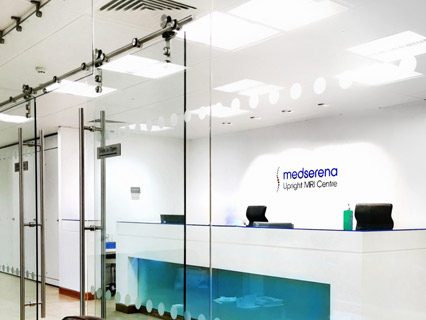
MRI for lower back pain
An MRI scan for lower back pain shows the lumbosacral spine and can reveal the causes of chronic backache and discomfort.
Lower back pain affects a third of the adult population in the UK every month and up to 60 per cent of adults can expect to suffer low back pain at some point in their life. Whilst most attacks resolve within a matter of weeks or months, 5 to 7 per cent of older adults over 45 are chronically disabled by lower back pain and even the figure for under 45’s is 3 to 4 per cent. People with chronic lower back pain often battle to find the cause and effective treatment. Indeed, lower back pain accounts for 11 per cent of total disability in the UK and every year 10,000 people in the UK undergo spinal surgery.>

Medserena’s MRI for lower back pain
Medserena offers a specialist MRI for lower back pain called the Lumbar spine MRI scan. Its big advantage over a conventional flatbed MRI tunnel scan is that the upright spine can be viewed in a neutral upright position. Imaging can also be used to view the lower back from various angles such as standing, sitting, leaning forward, and stretching back, using Medserena’s variPOSE sequence of MRI scans, so it is seen when weight bearing under the natural load of gravity.
This gives a dynamic picture of what is happening in the spine when it is subjected to normal everyday pressures such as sitting and standing, picking up problems that might have been missed or underestimated on a conventional flatbed MRI scanner.
In a seated position it may be possible to more accurately measure disc bulges and how far they may slip forward or backwards in alignment compared to being laid flat, as well as potentially give a more accurate picture of how much the canal width has been reduced.
The seated and open design of this scanner also makes it more comfortable for patients whose pain is brought on by laying on their back to be scanned. It can also be easier for patients whose spine is scoliotic (curved sideways), or kyphotic (an excessive outward curve of the spine resulting in an abnormal rounding of the upper back).
What can an open MRI for lower back pain show?
- Degeneration of the ligamentum flavum: This is the medical name for thickening of paired ligaments that run between vertebrae, they can cause stenosis (narrowing) of the spine.
- Prolapsed discs: An open MRI for lower back pain can pick up discs that prolapse (herniated or slipped) when the spine is bent or extended.
- Spondyloarthritis (or spondyloarthropathy): This is the name for a family of inflammatory rheumatic diseases that cause arthritis. It differs from other types of arthritis because it involves the sites where ligaments and tendons attach to bones called entheses. Symptoms include inflammation causing pain and stiffness, most often in the spine, but some forms can affect the hands and feet or arms and legs. The second type of symptoms cause bone destruction causing deformities of the spine and poor shoulder and hip function. The most common type is ankylosing spondylitis, which mainly affects the spine.
- Spinal instability: Scans which show bending and extending are the only method for showing up spinal instability that can occur after spinal fusion.
- Cancer of the spine: Spinal tumours will be visible on an MRI scan for lower back pain.
- Spinal fracture: One in two women and one in five men over 50 will suffer a bone fracture due to the fragile bone disease osteoporosis, caused by loss of bone density. Around 500,000 osteoporotic fractures are treated by the NHS every year. The spinal vertebrae can crumble and collapse leading to pain, height loss and compression of organs.
- Lumbar spinal stenosis: Narrowing of the spinal canal which contains the spinal cord is a significant cause of disability in the elderly, and the most common cause of spinal surgery in patients over 65 years. It is one of the most common causes of nontraumatic spinal cord injuries in people older than 50 years.
MRI scans for lower back pain
Other benefits of a Medserena MRI for lower back pain
Open MRI scanners are a stress-free alternative to using a conventional enclosed tunnel MRI scanner, providing comfort and reassurance for people who suffer from anxiety or claustrophobia. Sitting upright is more comfortable for patients and the open front means patients can speak to a friend or relative or watch television throughout as distraction.
Open MRI scans can also accommodate larger/ heavier patients who might have difficulty fitting comfortably into a conventional tunnel scanner, as they can take weights of up to 35 stone (226kg). However, suitability will depend on the patient’s build and the area of anatomy that needs to be scanned.
Available to self-pay clients, clients with private health insurance and NHS patients where prior funding has been agreed by a clinical commissioning group.
Location for Truly upright Spine & Back MRI scans
Our scans can be performed in London or Manchester
From only £570.00
Prices are self-pay only, inclusive of Radiologist report
Same day appointments
Many MRI scans can be booked for the same day




